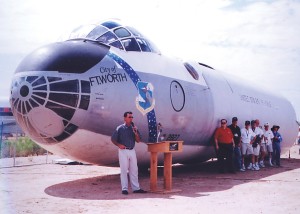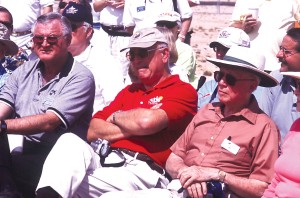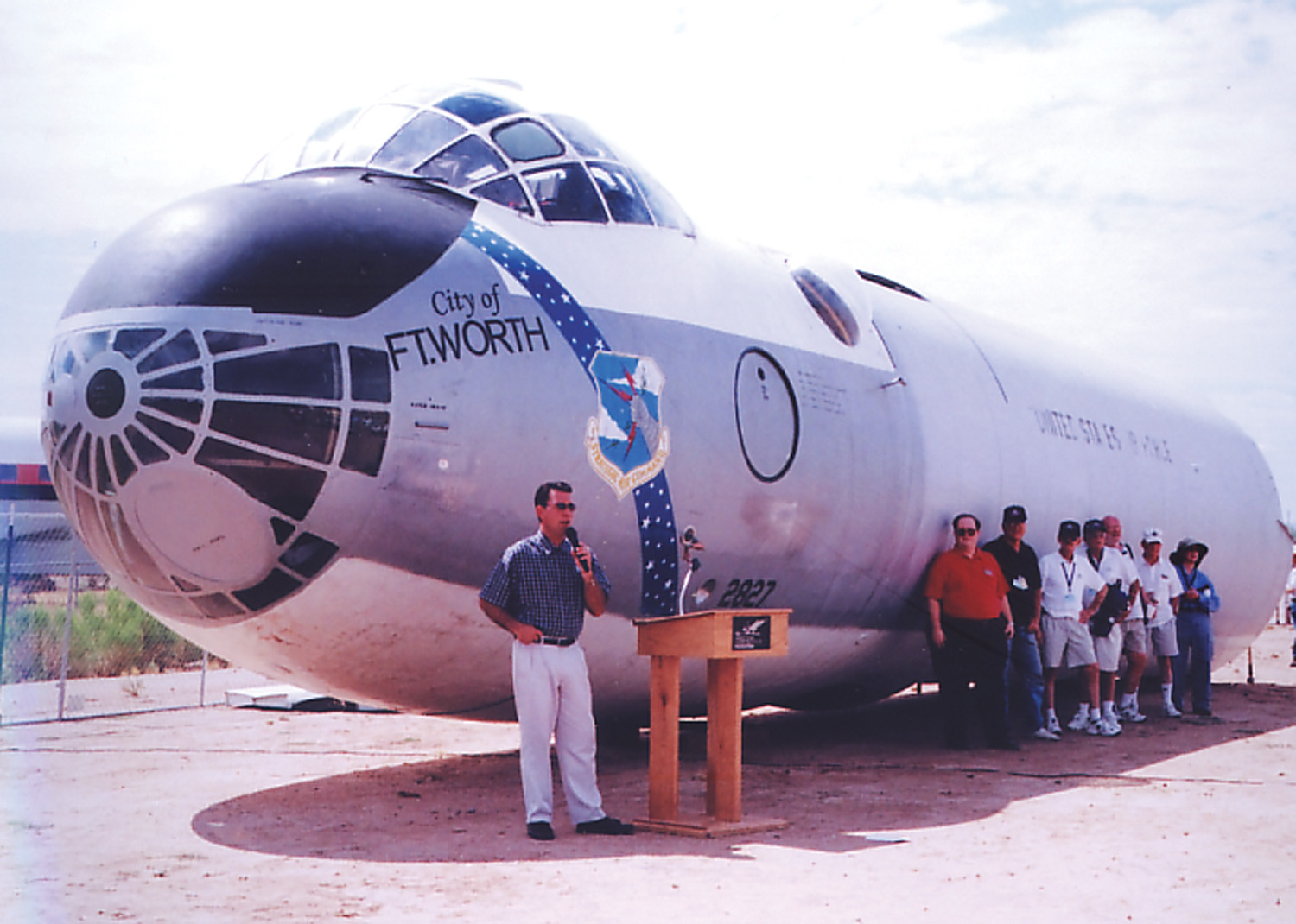By Bob Shane

Standing at the nose of the “City of Ft. Worth,” Dan Ryan, executive director of the Pima Air and Space Museum, addresses the invited guests during the B-36 arrival ceremony.
On July 22, at 5 p.m., a tractor-trailer hauling a very special oversized cargo pulled into the Pima Air and Space Museum in Tucson. On the big rig’s flatbed trailer was the cockpit and nose section of the largest bomber ever built in this country, the Convair B-36 Peacemaker.
By every measure, it’s a titan of an airplane. It has a 230-foot wingspan, a length of 162 feet, 1 inch, and stands 46 feet, 9 inches tall. Loaded, it weighed 410,000 lbs. and the power of its 10 engines (six Pratt and Whitney R4360 pusher prop engines and four General Electric J-47 jet engines) could make the ground shake. The recon model was manned by a sizeable 22-person crew. There was even one variant of the bomber, the B-36D “FICON,” which carried it’s own fighter protection. In this configuration, the intercontinental bomber had a Republic F-84F slung on a trapeze under its belly.
Over the next couple of weeks, it was anticipated that an additional 15 truckloads would be required to move all of the remaining parts needed to reassemble the giant aircraft. A fenced-in compound has been set up at Pima to store the parts and complete the detailed restoration and assembly. The public will be able to view the progress being made during the entire process.
Following the arrival of the nose section on Friday, the next morning at 10 a.m., a formal ceremony was held at the museum. Welcoming the B-36 to Arizona was Tucson Mayor Bob Walkup and other distinguished guests. Pima’s acquisition of the giant bomber was made possible through a loan agreement with the Air Force Museum.
Dan Ryan, the Museum’s executive director, opened his comments by stating, “Is this a great day for the Pima Air and Space Museum or what!” He thanked the Texas groups in Fort Worth for their steadfast dedication and many years of work in preserving the B-36. Undoubtedly, when completed, the “City of Ft. Worth” will become the centerpiece of the museum.
Also present to welcome the museum’s newest attraction were several former B-36 crewmembers. Bill Lafferty, who now resides in Green Valley, Ariz., was an aircraft commander on the bomber. He logged 1,800 hours flying the RB-36H. Lafferty likes to boast that the Peacemaker was “the first plane I flew that was overpowered.” He recalls one mission where he and his crew spent six hours trying to get the left landing gear down. When asked by Command if he was going to ride it in or bail out, he figured he had one last thing to try.
“I dived the airplane and pulled up hard and the gear popped out,” he said. In addition to flying the mammoth bomber, during the period 1952 to 1957, Lafferty also flew C-47s and C-54s during the Berlin Airlift.

Tucson Mayor Bob Walkup (red shirt) listens to B-36 crewmembers talk about their experiences flying the nation’s largest bomber.
Robert Kleinhans, who also attended the ceremony, accumulated 1,000 hours in the B-36 as the lower left gunner.
“We had an engine fire on number four where the flames extended all the way back to the horizontal stabilizer,” he recalls of one flight.
The fire was extinguished and the aircraft landed safely.
The B-36 made its maiden flight on Aug. 8, 1946, with the first aircraft being delivered to the Strategic Air Command on June 26, 1948. The particular aircraft received by Pima, the “City of Ft. Worth,” was the last B-36J built. With the serial number of 52-2827, it rolled off the Convair assembly line in Fort Worth, Texas in 1954, and was assigned to the 92nd Bomb Wing at Fairchild AFB in Spokane, Wash. It ended its active service in February 1959, following a retirement ceremony at Fort Worth’s Amon Carter Field, where it was placed on display in front of the airport’s terminal building in Peacemaker Park.
The rare bomber endured periods of neglect and vandalism. In 1978, disassembly of the aircraft was started so that it could be moved to Carswell AFB. In 1994, a B-36 restoration team completed a 44,000-man-hour reconstruction of the aircraft. Pima will now perform a detailed restoration during the reassembly of the bomber.
The B-36J is a national treasure and will be a valuable addition to the more than 250 historical aircraft already on display at the museum. Of the more than 380 built, only four have survived the scrapper’s blade. All but these four were parted out in Tucson after their retirement. The Pima Air and Space Museum will now join only three other museums in the country with a complete B-36. They include the National Museum of the United States Air Force in Dayton, Ohio, the Strategic Air and Space Museum near Omaha, Neb., and the Castle Air Museum in Atwater, Calif.












